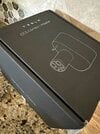Good points but I have some arguments as well. I spent the whole weekend studying my Tesla original adapter, watching some videos and studying what A2Z came with. The safety pin on the Tesla adapter is not essential for the charging process. It adds a layer of safety to prevent the CCS plug from being removed from the adapter. That saying, I’ve went to a couple charging stations and all of them have the same safety measure. When pressing the release button on the CCS handle it stops the charging. That being said, if you have an oem adapter and your pin is broken, you can still use the adapter. This is mostly a reflexion for me because at first and like many others, I thought that there was some kind of switch related to the pin and when depressed it stopped the charging process. But no. I think the safety pin is not really required since the charging stations have their own security measures.I was referring to some as-yet-unreleased Chinese-made clones of Tesla's CCS1 adapter, as described by @Chrushev. The A2Z adapter is entirely different.
That said, the A2Z adapter, like the Ukrainian-made CCS1 adapter that's now impossible to obtain new because of the war, lacks a means to lock the CCS1 plug to the adapter. My understanding is that this is a violation of the CCS1 specification, and it's similar in that respect to the Setec CCS1 adapter, which Tesla has been in a whack-a-mole game with to disable the adapter; Tesla has done so two or three times, and Setec has updated their firmware to get around Tesla's blocking it. (Setec's adapter is active and spoof's Tesla's CHAdeMO adapter, which makes it vulnerable to Tesla disabling it. In the last round, Tesla didn't fully disable the adapter, just displayed a warning message on the car's screen, so the two companies may have settled into a sort of detente.) The ability to lock the adapter to the CCS1 plug is a safety feature, but I've seen differing opinions as to how important it is, since there are other safety features that should prevent problems even if the locking feature is broken or absent. As we're talking about very high voltages and currents, though, it's disappointing that A2Z didn't implement such a lock in their design. I can't speak to the quality of the design in terms of the build quality, conductor sizes, etc. Those are the hidden characteristics I'd be concerned with in the case of Chinese clones of Tesla's adapter. Based on @Chrushev's description, it sounds like the Chinese clone he's seen at least includes a Tesla-esque locking tab.
I know this is not comparable, but at least A2Z has the ability to lock into the handle. You can clearly hear the click. Also it locks into the vehicle when it’s charging, you adapter can’t be removed unless you have stopped putting juice into your car. Of course, there is place for some improvement and us as a community can help them. They have a great product, I tested it and been in contact with another member here, Julia. She shared with me some feedbacks, I think it’s going to be a real success. I told them about the safety pin and people talking about it, they said they will come up with improvements.
And as you said, I’d be more concerned on the Chinese clone as it looks like the original and they may cheap out on internals without people being concerned since some owners may simply think it’s the original



